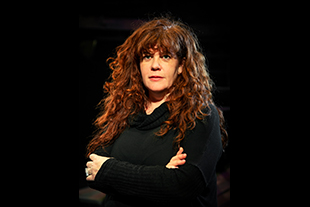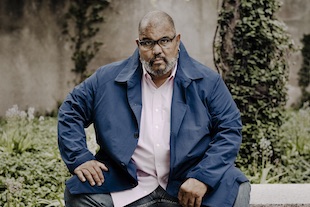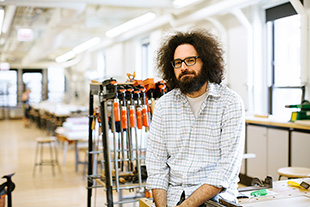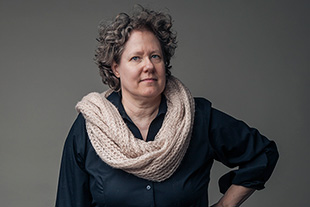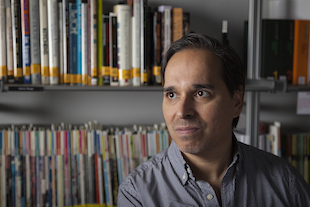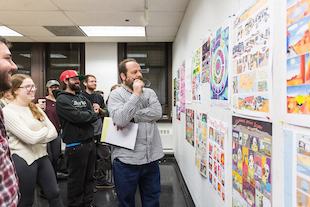Brendan Riley
English and Creative Writing
The associate professor of English considered becoming a librarian before coming to Columbia and developing a course about zombies that’s received national attention.
When a zombie outbreak finally comes, associate professor Brendan Riley says his preferred weapon of defense against the dead would be simple: a crowbar. “All bludgeoning weapons are most useful,” Riley says. “But if you’re at the point where you have to kill zombies, you’re probably already dead.”
The English professor is most known at Columbia College Chicago for his class Zombies in Popular Media, a three-week, three-credit course offered during the J-terms. The class has received national media attention, and Riley has presented widely on the subject.
The Study of Zombies
Much of the material in Zombies in Popular Media revolves around philosophical, historical, and theoretical perspectives on the zombie figure. Riley asks his students to analyze and discover the underlying questions that zombie movies and books address, such as how people relate to one another, how to trust people in times of need, and what zombies can teach us about being human.
“I want my students to leave the class being able to say that this piece of zombie media helps them understand the world in different ways,” Riley says. The professor notes that he considered becoming a librarian before his sophomore year of college, when he started envying a film studies professor because he was teaching a class that Riley loved—and getting paid for it.
Pop Culture Connoisseur
In addition to teaching English courses at Columbia (he also teaches Literary Genres: Detective Fiction and Rhetoric of Digital Media, among others), Riley is the executive director of operations at the Popular Culture Association/American Culture Association, a scholarly group that holds an annual, four-day conference covering more than 110 areas of popular culture. He co-organizes the event, which draws scholars from around the world, and he helps maintain connections among the group members throughout the year.
Having taught at Columbia since 2004, Riley says he is most happy when he is redesigning his course material in new ways in order to engage every student in the classroom, no matter their major. “Columbia students have an artistic temperament unlike anywhere else,” he says. “They’re willing to engage with unusual assignments, and they bring creative work and ideas to class.”
-
Brendan Riley’s top five zombie films:
Dawn of the Dead (1978)
“Romero’s classic set many ground rules for the genre. We love watching the heroes revel in the mall, but too quickly the fantasy fades and they become as directionless as zombies. We’re reminded that survival means more than just staying alive—it means remembering to live.”Zombie Honeymoon (2004)
“When Danny gets bitten and starts turning into a zombie, Denise must decide how far she’s willing to go to stay by her new husband. This film about ethics and love pushes us to ask how far we would go for the love of our life.”Invasion of the Body Snatchers (1956)
“How much can someone change before they are no longer themselves? This venerable parable about groupthink and social pressure gets to the heart of this question. Sometimes, all we can do to save ourselves is run into traffic shouting, ‘You’re next!’”Pontypool (2008)
“A tiny Canadian town finds itself the locus of an outbreak in which each new piece of information puts everyone in more danger. As their community tears itself apart, our heroes try to comprehend a disease that unmakes the most human thing we have: language itself.”Fido (2006)
“Perhaps the strangest film on this list, Fido challenges our notions about friendship, parenthood, propriety, and society. It asks what we owe to one another, and how we can be true to ourselves. And it asks what Lassie might have been like as a zombie story.”
Visit the School of Liberal Arts and Sciences YouTube channel to watch Riley present “People, Zombies, and the Blurry Line Between Them.” The talk was part of the Honors Program discussion series, What’s the Big Idea?


